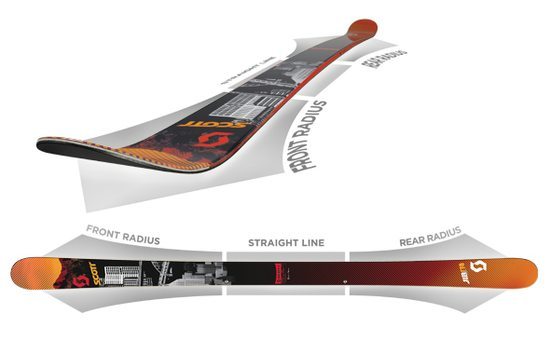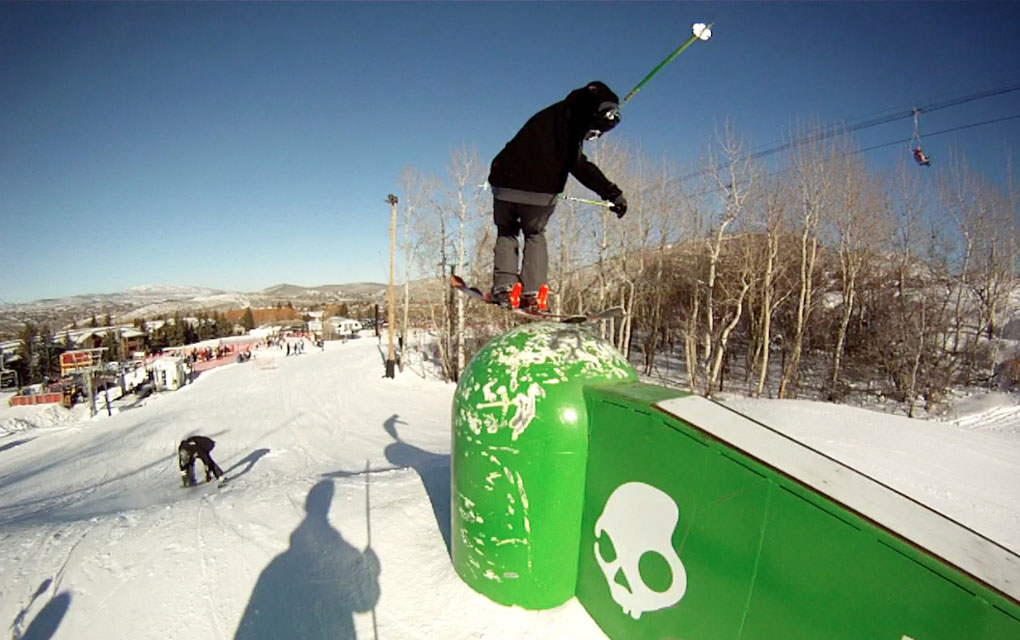Jumps / Stability
The soft flex pattern and light weight of the Jib TW translated somewhat poorly to jumps. Yes, the light swing weight did make executing the tricks quite easy while in the air, but as soon as it came time to put down the landing gear, the Jib TW wasn’t the most dependable ski.
I don’t expect a ski to land my jump tricks for me, but I felt that the Jib TW didn’t do me any favors when reining in off-kilter landings. When landings got rough, the ski just wouldn’t remain as solid and stable as I would have liked or expected. The softness caused it to waver, often over-flexing and not helping me to hold on to slightly off-balanced landings. If I landed a bit heavy on my tips when landing switch, it felt as though the ski had very little rebound to keep me on my feet. I experienced the same phenomenon when landing forward in the backseat, and this would cause me to wash out more often than a ski with more recoil, like the Atomic Punx.
I didn’t particularly notice any added stability as a result of the “3Dimension” sidecut, either (which supposedly improves stability and turn initiation). From my understanding of the technical description on the SCOTT website, the shape of the ski has three distinct sections, or radii as they refer to them: The tip of the ski has one radius (the “front” radius), followed by a straight section underfoot, then a second “rear” radius in the tail. The front and rear radii are said to ease turn initiation while the underfoot section provides stability, power, and precision.

After spending fourteen days in the park and on groomers, moguls, and even powder, I didn’t experience any issues initiating turns, but I also didn’t feel as though it allowed me to initiate turns particularly easily, either. Likewise, I didn’t feel any added stability as a result of the straight shape underfoot.
Durability
It needs to be understood that I am extremely hard on my equipment, and you may not be.
I frequently find edge cracks on skis that I have ridden for only five days or less. In the past three years, the longest I’ve made a park ski last is about three months, riding five days a week.
So it would be unfair of me to say that the SCOTT Jib TW has edge durability issues, because I skied them extremely hard and hit an absolute boatload of rails while doing lots of high-impact rail tricks during the test period, such as gaps to flat on down-flat-down rails.
With that said, I had numerous edge cracks and the edge began to pull away from the sidewall after about fourteen days of riding. But I experienced this same kind of edge damage on the Nordica Ace of Spades Ti in a similar timeframe in March of last season, and I consider the Ace of Spades to be a fairly durable ski.
Other aspects of the ski have remained pretty bombproof. In particular, the tips and tails showed no sign of impending delamination after some heavy impacts on jumps, as well as the one time I accidentally ran one of the tips into the side of a box quite hard.
Around the tips, the edge connection points remained solid and unscathed through this abuse, which is an issue I have been more cognizant of since I experienced total failure of them with the Bluehouse Antics last season.

Additionally, the top sheet has sustained extraordinarily little damage. Granted, top sheet damage is mostly cosmetic, but I was impressed nonetheless by the incredibly small amount of top sheet chipping and scratching.
In large part, I think this was due to the Sandwich Sidewall Construction Laminate (SSCL) design, which effectively means SCOTT combined elements of sandwich/sidewall construction with elements of cap construction to take advantage of each design. The aspects of sandwich and sidewall construction give the ski pop and responsiveness, while the cap elements decrease the risk of tip delamination.
This design is very similar to that of the Line Stepup, which I praised in my review of the Stepup for its stability and pop. The Jib TW isn’t nearly as stiff in the core of the ski as the Stepup, and I believe that the Jib TW isn’t as stable as a result. Still, the cap-sandwich hybrid construction provides responsive flex and pop that is reminiscent of the Stepup.
Bottom Line
It seems to me that the SCOTT Jib TW was engineered more for Tom’s ninja-like rail abilities than his Dew-Cup-winning slopestyle efforts. The Jib TW is a fun ski to hit rails and mess around in the park, but despite being the signature model of on of the most dominant slopestyle riders, it doesn’t ride like a burly competition ski that was built to launch off big kickers.
The light swing weight and soft flex pattern make rail tricks effortless and enjoyable, but those attributes don’t translate all that well to landing big jumps, since the ski tends to over-flex on high-impact landings, leading to instability and scrubbed landings in these situations.
But if you’re mostly looking for a fun, soft jib ski to cruise the rail line, the Scott Jib TW would be a great choice.

You see Tom Wallish rocking AR7 is many new videos released in the past months. So in conclusion, he doesn’t seem to like his own ski as much one might think. This speaks for Tom. Do you think if the TW Jib Skis would have been wider in the waist it would have been more stable in the park? I’m asking because I can’t decide between a 80mm or 90mm underfoot TwinTip Ski at the moment. (Colby XX80 or James XX90). I noticed the Scott Jib TW is only 83mm underfoot, similar to the Colby’s 80mm, whereas the AR7 and Chronic have around 90mm in the longer lenghts. Cheers.
I’m not sure that Tom has been skiing the AR7 recently given his contract with Scott.
In terms of correlating waist width and stability, it isn’t as black and white as saying that a wider ski will guarantee greater stability. The Atomic Punx, which is even narrower at 82 mm underfoot, is one of the most stable par skis I’ve ever ridden, and it’s even narrower than the Jib TW (which is 86 mm underfoot, not 83 mm). I found the Jib TW to be unstable at faster speeds and on greater impacts because it is a very soft ski with very little rebound from the core.
I know very little about Colby West’s skis from Kastle, but I would look more into other aspects of the ski like the flex pattern than making a judgement about stability based on waist width. Width should come into consideration more when determining what you want to get out of your ski. If it’s just going to be a dedicated park ski, I’d probably recommend a narrower width, but if you plan to ski some bigger lines and get more float out of the ski on deep days, definitely go with the wider width.
Hope that answers your question.
Honestly stay away from these skis or any Scott jib. They are so fun but they last literally two weeks.
Where is centre of the ski in relation to the mounting point? There are marks for up to +3 of mounting point is it further forward still?